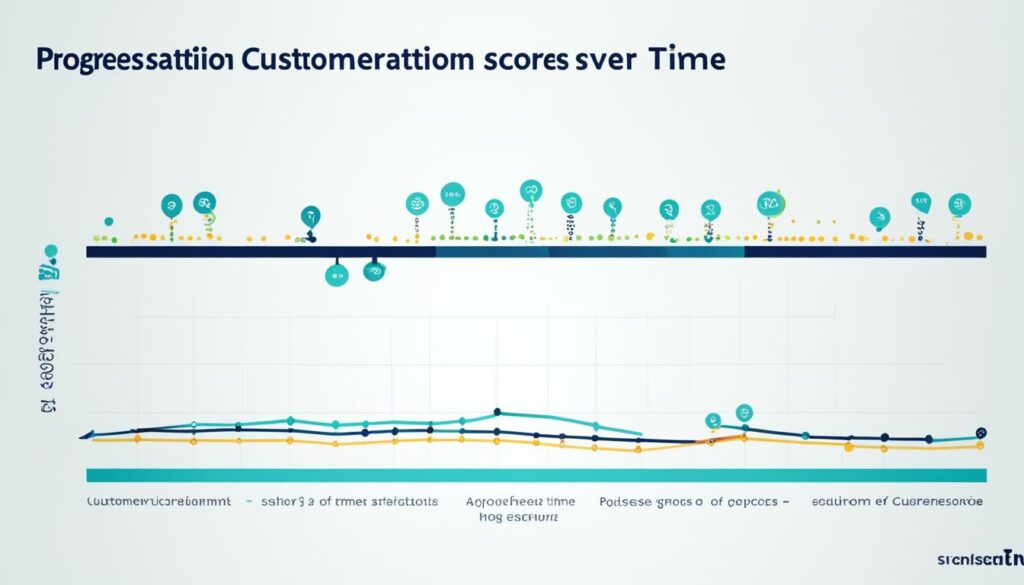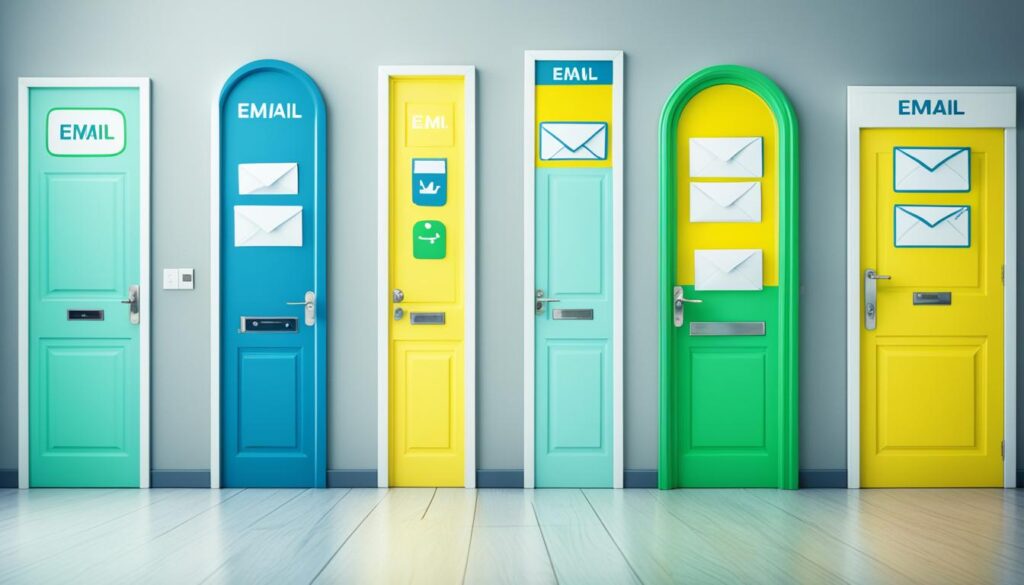Customer service is a critical aspect of any successful business. It can make or break customer satisfaction, impact brand reputation, and drive customer loyalty. But have you ever wondered how you can improve your customer service performance? What strategies can you implement to deliver excellent customer service consistently?
When it comes to customer service, there are various skills, strategies, and tactics that can help you enhance your performance and exceed customer expectations. From optimizing processes to understanding customer needs and setting performance metrics, every aspect plays a vital role in delivering exceptional customer service.
In this article, we will explore proven techniques and best practices for improving customer service. Whether you are a customer service professional looking to enhance your skills or a business owner aiming to elevate your team’s performance, this guide will provide you with valuable insights and actionable strategies that can help you achieve customer service excellence.
Are you ready to take your customer service performance to the next level? Let’s dive in and discover the key strategies for improving customer satisfaction and delivering exceptional customer service!
Understanding Customer Needs
Understanding and meeting customer needs is the foundation of delivering exceptional customer service. By gaining insights into their preferences, expectations, and pain points, you can tailor your service to exceed their expectations and increase customer satisfaction.
One effective way to gather information about customer needs is through feedback channels such as surveys, emails, or phone calls. These methods provide valuable insights into what customers are looking for and allow you to address any gaps in your service. By actively seeking feedback, you demonstrate your commitment to meeting their needs.
When interacting with customers, it’s essential to make them feel valued and appreciated. Actively listen to their concerns and ensure prompt responses. By showing empathy and understanding, you can create a positive experience that fosters long-term customer relationships.
Incorporating empathy into your performance coaching initiatives can have a significant impact on customer satisfaction. Train your team to put themselves in the customer’s shoes, understanding their perspective and needs. This approach helps build rapport and trust, leading to improved customer relationships.
Understanding customer needs is an ongoing process, as preferences and expectations may change over time. Regularly review and analyze customer feedback to stay up-to-date and adapt your service strategy accordingly, ensuring you meet and exceed their evolving requirements.
Examples of Customer Needs and Corresponding Service Strategies
| Customer Need | Service Strategy |
|---|---|
| Ease of communication | Offer multi-channel support (phone, email, chat) and timely responses |
| Quick problem resolution | Empower frontline staff with problem-solving authority and streamline processes |
| Personalized service | Utilize customer data to provide tailored recommendations and personalized experiences |
| Proactive communication | Send timely updates, notifications, and proactive problem-solving |
Understanding and addressing customer needs lays the groundwork for building strong customer relationships and fostering loyalty. By continuously adapting your service strategy based on customer feedback, you can enhance customer satisfaction and drive business success.
Setting Performance Metrics
Setting clear performance metrics is essential for driving continuous improvement in customer service. By measuring key performance indicators (KPIs) and tracking important metrics, you can assess the effectiveness of your customer service strategies and identify areas for improvement. Here are some crucial performance metrics and their significance:
Customer Satisfaction Scores
Customer satisfaction scores (CSS) measure how satisfied customers are with the service they receive. By collecting feedback through surveys or post-interaction emails, you can gauge how well your team is meeting customer expectations. CSS provides valuable insights into areas that need improvement and helps to prioritize customer-centric initiatives.
First Contact Resolution (FCR)
First contact resolution refers to the ability to resolve customer issues or inquiries during the initial interaction. A high FCR rate indicates efficient problem-solving and reduces the need for customers to follow up multiple times. Improving FCR requires effective training, knowledge management systems, and empowering frontline employees with the authority to address customer concerns.
Average Resolution Time (ART)
Average resolution time measures the average duration it takes to resolve customer issues. It’s a crucial metric for assessing the efficiency of your support processes. By benchmarking ART, you can identify bottlenecks, streamline workflows, and reduce customer wait times. Faster resolution times lead to higher customer satisfaction and increased operational efficiency.
Employee Engagement
Employee engagement plays a vital role in delivering exceptional customer service. Highly engaged employees are more likely to go the extra mile, provide personalized service, and resolve issues effectively. To measure employee engagement, you can use surveys or feedback platforms to understand their satisfaction levels, motivation, and alignment with organizational goals. By fostering a positive work environment and engaging employees, you can improve overall customer service performance.
Setting performance metrics allows you to monitor progress, align team goals, and provide valuable feedback to drive continuous improvement. By tracking these metrics, you can identify specific areas for improvement and make data-driven decisions that enhance customer satisfaction and service quality.
| Metric | Description | Importance |
|---|---|---|
| Customer Satisfaction Scores (CSS) | Measures customer satisfaction with the service | Indicates overall customer sentiment and loyalty |
| First Contact Resolution (FCR) | Determines the percentage of issues resolved during the first interaction | Reduces customer effort and increases efficiency |
| Average Resolution Time (ART) | The average duration to resolve customer issues | Improves customer experience and operational efficiency |
| Employee Engagement | Measures the level of employee motivation and dedication | Directly impacts the quality of customer interactions |
Equipping your team with the right metrics and goals is only the first step. It’s crucial to consistently track performance, analyze trends, and provide timely feedback to address any challenges that arise. Emphasizing a data-driven approach and fostering a culture of continuous improvement will help your customer service team excel.

Streamlining Processes
Improving customer service efficiency and effectiveness requires streamlining processes through the use of customer service software, automation, and effective quality assurance checklists. By optimizing processes, you can save time, reduce errors, and increase productivity, ultimately leading to improved customer satisfaction.
One way to optimize processes is by leveraging customer service software. These software solutions provide comprehensive tools and functionalities to streamline various tasks, enhance workflow, and improve overall efficiency. For example, customer relationship management (CRM) software can centralize customer information, facilitate communication, and help agents respond more effectively to customer inquiries.
Automating Routine Tasks
Automation plays a crucial role in streamlining customer service processes. By automating repetitive and routine tasks, such as data entry, ticket routing, and follow-up emails, you can free up valuable time for your customer service team to focus on more complex issues and personalized interactions.
Automated reporting is another valuable feature offered by customer service software. With automated reports, you can generate real-time insights, track key performance indicators (KPIs), and identify areas of improvement more efficiently. This enables you to make data-driven decisions and implement targeted strategies to enhance customer service performance.
Quality Assurance and Performance Coaching
Implementing a robust quality assurance checklist is essential for ensuring consistently high levels of service quality. A quality assurance checklist provides a systematic approach to evaluating customer interactions, identifying areas for improvement, and maintaining service standards.
Clear and consistent quality feedback is also crucial in streamlining processes and improving performance. Through regular feedback sessions and performance coaching, you can address individual strengths and weaknesses, provide guidance, and empower your team to deliver exceptional customer service.
“Automation is not a replacement for human interaction. It is an enabler that allows customer service representatives to focus on building meaningful relationships with customers.”

Streamlining processes is an ongoing effort that requires continuous evaluation, refinement, and optimization. By leveraging customer service software, automation, and quality assurance checklists, you can enhance efficiency, reduce errors, and deliver a seamless customer experience.
Enhancing Accessibility
Creating accessibility for customers is crucial in providing excellent customer service. By utilizing various channels, such as email, social media, and messaging platforms, you can improve the overall customer experience. These customer service channels allow for seamless communication and swift responses, ensuring customer satisfaction.
Additionally, implementing customer self-service (CSS) options like FAQ pages, help centers, and community forums can empower customers to find solutions on their own. These resources provide valuable information and troubleshooting steps, reducing the need for direct customer contact and saving time for both the customer and the support team.
Efficient Email Support
Email support is a widely used customer service channel. It allows customers to reach out to your company at their convenience, without the need for immediate response. To ensure effective email support:
- Respond promptly and within the promised timeframe.
- Use clear and concise language to address customer queries or concerns.
- Personalize responses to make customers feel valued and understood.
Engaging on Social Media
Social media platforms provide an opportunity to engage with customers on a more personal level. When interacting on social media:
- Monitor and respond to customer comments, mentions, and direct messages promptly.
- Resolve issues publicly when appropriate, demonstrating a commitment to customer satisfaction.
- Use a friendly and professional tone to maintain positive brand representation.

Image: Enhancing accessibility through various customer service channels.
Utilizing FAQ Pages, Help Centers, and Community Forums
Customer self-service options like FAQ pages, help centers, and community forums can be invaluable resources for customers seeking quick solutions. When implementing these tools:
- Create a comprehensive FAQ page that addresses common customer inquiries.
- Develop a user-friendly help center that provides step-by-step instructions and troubleshooting guides.
- Maintain an active community forum where customers can share insights and help one another.
By offering a range of customer service channels and self-service options, you can cater to different customer preferences and enhance accessibility. These strategies contribute to a positive customer experience, increased customer satisfaction, and efficient issue resolution.
Promoting Transparency and Communication
Promoting transparency and open communication within the team and with customers is essential for establishing strong relationships and improving overall communication. By fostering an environment of transparency, you can build trust and enhance collaboration among team members, leading to increased efficiency and productivity.
One effective way to promote transparency is by providing real-time data and performance metrics to your team members. This allows them to have a clear understanding of their individual and collective performance, enabling them to make data-driven decisions and take proactive measures to improve.
Utilizing technology, such as customer service performance management software, can significantly aid in promoting transparency and streamlining communication. This software provides real-time insights and analytics, allowing you to track and measure key performance indicators and monitor customer service performance effectively.
Feedback is another crucial aspect of promoting transparency. Encouraging your team members to provide feedback and suggestions creates an environment where everyone’s opinions are valued. Implementing an open-door policy and regularly soliciting feedback ensures that any issues or concerns are addressed promptly, leading to continuous improvement.
“Transparency creates trust, and trust is the foundation of great teamwork” – Patrick Lencioni
In summary, promoting transparency and communication is vital for fostering a cohesive and productive customer service team. By providing real-time data, utilizing technology, and encouraging feedback, you can create a work environment that values transparency and open communication, ultimately leading to improved performance and customer satisfaction.
Benefits of Promoting Transparency and Communication:
- Builds trust among team members
- Enhances collaboration and teamwork
- Improves decision-making through access to real-time data
- Increases productivity and efficiency
- Facilitates prompt issue resolution and continuous improvement
Creating an Engaging Work Environment
Creating an engaging work environment is essential for fostering employee engagement, promoting team spirit, and improving customer service performance. By incorporating gamification, rewards programs, and recognition into the workplace, you can enhance employee happiness, reduce turnover, and increase motivation.
Gamification is an effective strategy to keep employees engaged and motivated. By incorporating game elements into work tasks and processes, such as setting targets, tracking progress, and rewarding achievements, employees are more likely to enjoy their work and feel a sense of accomplishment. This not only boosts team morale but also encourages healthy competition and drives performance.
“Introducing gamification in our customer service department has been a game-changer. Our employees are more motivated and enthusiastic about their work. They strive to achieve targets and earn rewards, which has significantly improved our team’s performance.”
Rewards programs are another effective way to create an engaging work environment. By offering incentives, such as bonuses, gift cards, or extra time off, you can show your appreciation for employees’ hard work and dedication. This not only boosts morale but also reinforces a culture of recognition and excellence.
Recognition plays a crucial role in creating an engaging work environment. Acknowledging employees’ achievements and contributions, both monetarily and non-monetarily, fosters a sense of belonging, increases confidence, and motivates them to perform their best. Implementing a recognition program, such as “Employee of the Month” or quarterly awards, can encourage healthy competition and inspire individual and team growth.
Building a strong team spirit is essential for maintaining an engaging work environment. Encourage collaboration, open communication, and mutual support among team members. Promote team-building activities, such as retreats, workshops, or social events, to strengthen relationships and foster a sense of camaraderie. When employees feel connected and valued within their team, they are more likely to work together harmoniously and deliver exceptional customer service.
Benefits of an Engaging Work Environment:
- Increased employee happiness and job satisfaction
- Reduced turnover and improved employee retention
- Enhanced motivation and productivity
- Improved team communication and collaboration
- Higher levels of customer service performance
Creating a vibrant and engaging work environment is an investment that yields significant returns. By prioritizing employee engagement, incorporating gamification and rewards programs, fostering recognition, and nurturing team spirit, you can cultivate a positive workplace culture that inspires exceptional customer service and drives business success.
Conclusion
Great customer service is of utmost importance for the success and loyalty of your business. By understanding and meeting customer needs, setting performance metrics, streamlining processes, enhancing accessibility, promoting transparency and communication, and creating an engaging work environment, you can significantly improve your customer service.
To excel in customer service, it is crucial to practice active listening and empathy towards your customers. By using positive language, continually improving your technical knowledge, and being genuine in your interactions, you can personalize the customer experience and ensure clear communication.
Remember, a personal approach and clear communication are the key principles of exceptional customer service. By consistently implementing these tips and principles, you can enhance customer satisfaction, build long-term customer relationships, and drive the success of your business.
FAQ
How can I improve customer service?
Continually improving customer service performance is vital for driving company profitability. Some tactics to improve customer service include implementing a quality assurance strategy, gathering honest feedback from customers, and tracking performance with metrics such as customer satisfaction scores, first contact resolution, and average resolution time.
How can I understand customer needs?
Understanding and meeting customer needs is the foundation of good customer service. Conducting surveys, emails, or phone calls to gather specific feedback from customers can help identify their needs. It’s important to interact with customers in a way that makes them feel valued and satisfied with the service.
What are performance metrics and why are they important?
Performance metrics, such as customer satisfaction scores, first contact resolution, and average resolution time, are crucial for setting goals and providing direction to the customer service team. Working with the team to determine relevant and trackable KPIs can help everyone focus on improving performance. Each individual agent should also set their own goals based on the team’s agreed-upon metrics.
How can I streamline customer service processes?
Optimizing processes through the use of customer service software and automation can save time, reduce errors, and increase productivity. Using software to streamline tasks like calculating trends, automating reports, and providing quality assurance checklists can be beneficial. Clear and consistent quality feedback, combined with continuous coaching and mentoring, can help improve performance.
How can I enhance accessibility for customers?
Creating accessibility for customers through various channels like email, social media, and messaging platforms can improve the overall customer experience. Implementing customer self-service options like FAQ pages, help centers, and community forums can also reduce the need for direct customer contact. It’s important to identify the channels preferred by customers and focus efforts on those areas.
How can I promote transparency and communication in my team?
Promoting transparency and open communication within the team and with customers can solidify relationships and improve overall communication. Providing real-time data and performance metrics to team members can increase motivation and productivity. Utilizing technology like customer service performance management software can save time and improve efficiency in providing feedback and managing performance.
How can I create an engaging work environment for my team?
Creating an engaging work environment through gamification, rewards programs, and recognition can boost employee happiness, reduce turnover, and improve team spirit. Recognizing and appreciating employees, both monetarily and non-monetarily, can increase confidence and motivation. Building a team that values customer service and takes ownership of their goals and achievements contributes to better customer service performance.
What are the key principles of great customer service?
Great customer service is essential for business success and customer loyalty. It involves understanding and meeting customer needs, setting performance metrics, streamlining processes, enhancing accessibility, promoting transparency and communication, and creating an engaging work environment. Customer service professionals can also improve their skills by practicing active listening, empathizing with customers, using positive language, improving technical knowledge, and being human in their interactions. A personal approach and clear communication are key principles of great customer service.
